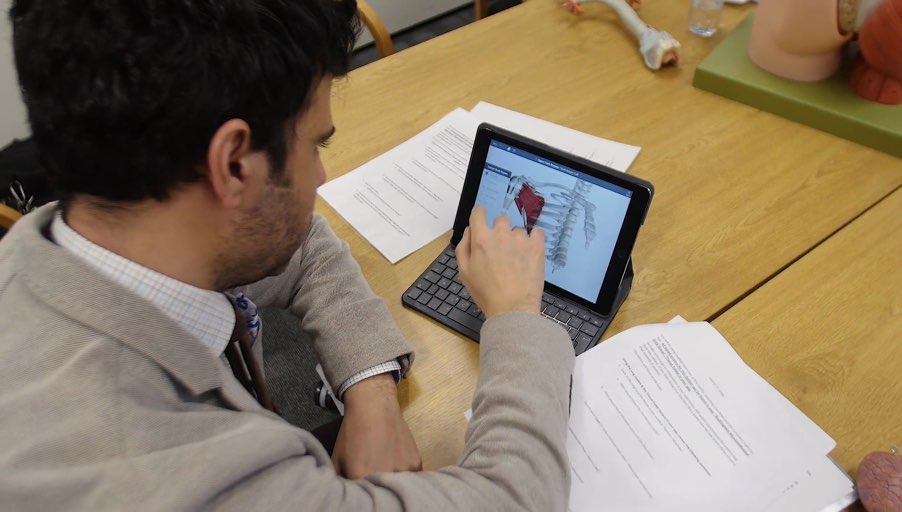
This month we spoke to Darren Hoffmann, Ph.D. with the University of Iowa Carver College of Medicine. Dr. Hoffmann, along with Vaelan Molian, B.S., published a study on full-body 3D anatomy apps available on the app stores. The study evaluated several 3D anatomy apps across usability, visual quality and additional learning content. You can view the full results of their research here.
3D4Medical: Let’s start with a bit about you. How long have you been working at the University of Iowa Carver College of Medicine and what are your current research interests?
Dr. Hoffmann: I’ve been at the UI for 13 years. My research interests are in anatomy/medical education (virtual anatomy technologies, integration of massage into anatomy learning) and training of graduate students for teaching roles in their future careers.

3D4Medical: At what point did you introduce 3D anatomy learning into your classroom? What made you make the leap to using this technology and how was the introduction among faculty and staff?
Dr. Hoffmann: I started integrating 3D anatomy into my classes probably as early as 10 years ago. But it was a while before a found a way to do it purposefully. At first I just offered the technology as an adjunct option for students to use if they wanted to. They were interested at first, but without a goal/purpose, the novelty wore off and folks didn’t use it much.
Later on, I found some specific classroom issues that could be addressed really well by good anatomy simulations. Specifically, these were preparation for lab dissection and introducing totally new regions of the body with really complex anatomical relationships.
The faculty in our department is kind of split. Some are really into it and have embedded 3D technologies into their courses, others are happy to continue doing things the way they have been. The college is really supportive of innovation of any kind, and they’ve been super supportive of this technology in our health professions programs.
“All students have different levels of spatial ability”
3D4Medical: What are some of the benefits to having access to a 3D anatomy learning resource as opposed to traditional 2D images?
Dr. Hoffmann: All students have different levels of spatial ability. So some students can look at a well-done 2D figure and understand all of the shapes and structure relationships. But most students have to do that really slowly and process it from multiple perspectives. Having a 3D model allows the student to integrate all of those perspective into one rotatable object. That is a HUGE difference, and saves a lot of time for both the instructor and the students.
There is still an important place for traditional 2D images – they constrain the viewer into thinking in planes and singular relationships. You need that when you’re first processing a new region (e.g. “Let’s look at this region in terms of Anterior-Posterior arrangement of structures, then let’s look at in terms of the Medial-Lateral relationships of the structures.”). But it’s really important that students think about the body as it actually is: tons of structures in very complex relationships with almost no truly flat surfaces.
Being able to play in the sandbox of the human body has been a critical part of addressing this learning goal for hundreds of years (dissection). And these virtual anatomy tools allow students to explore that complexity at home or wherever they want to study when they’re not in the lab. It’s a natural extension of a learning mechanism that we know works really well.

3D4Medical: In your study, Complete Anatomy ranks number 1 for quality in terms of its 3D models. How important is the quality of the graphics and textures for students learning anatomy?
Dr. Hoffmann: Visual quality is very important. Consumers have come to expect high quality graphics from the entertainment industry’s high quality work in 3D graphic design. I don’t think that 3D anatomy products should aim for photorealism, but there’s a kind of hyper-realism that’s captured in these products that really helps to create strong visual impressions. It’s no coincidence that most of these products use many of the same artistic styles as the classic anatomy atlases. This visual style works for anatomy learning.
When this visual style is done really well, with professional-grade shadows/lighting/textures, it is that much more visually arresting and this supports student attention and focus on the subject. We’ve all seen the “uncanny valley” in film and TV, and I think it’s a real thing in anatomy graphics too. When you stumble on a nerve that is not round, but squared off in a really unnatural way, it just takes you out of it and adds to the cognitive load of the simulation. I know that it takes a ton of time to create those textures and the programming that underlies it. But I really think it’s worth it to the user.
“I would never just put a student in a cadaver lab and expect them to figure it out. Why would I do that with a 3D simulation that’s equally complicated?”
3D4Medical: The report gives a thorough feature comparison of the 3D anatomy apps on the market, including course, lecture and quiz content. Can you explain how this content fits into your anatomy teaching on a daily basis?
Dr. Hoffmann: Students say that this type of guidance is very important for helping them see what to pay attention to. I noticed this issue early on when I put 3D anatomy tech in front of students without any guidance. They’d click around for maybe a minute before they’d ask me what they were supposed to be learning. Guidance is critical.
I always say that I would never just put a student in a cadaver lab and expect them to figure it out. Why would I do that with a 3D simulation that’s equally complicated?
3D4Medical: You mention in the study that student knowledge of the quality of these apps is limited by lack of expertise and faculty awareness; how can products like Complete Anatomy help faculty members to bring 3D anatomy learning into their classrooms?
Dr. Hoffmann: Meeting us where we are is important. Every faculty member believes that they are the busiest person in the world and they don’t have time to find solutions for themselves. Whether they’re right is besides the point. If you want to make an impact, be present at Anatomy conferences, continue to offer webinars on how the product works and how it can be integrated into a course, and if possible come to campus and show us AND OUR STUDENTS how cool the technology really is. Some of us are older and less interested in tech solutions that might be hard for us to implement. But when we see our students engaging with anatomy and really getting into it, it’s hard to say no to that.
3D4Medical: Finally, can you give us your top 3 tips for educators who use Complete Anatomy in their classrooms?
Dr. Hoffmann: Certainly:
- If you’re going to recommend a piece of technology to the students, make sure they know how and when to best use it.
- Don’t stress out about minor errors. There are anatomical issues in all of the products on the market (mislabels, disconnected structures, structures that are out of scale, etc.). That doesn’t mean that you should disregard the technology outright. I’m sure all of the classic anatomy texts had a lot of issues in their first editions too. Collaborate with product developers to improve their quality and everybody wins.
- Choose specific points in the course to demonstrate how helpful the software is by teaching with it. Pelvic floor and perineum is my go-to introduction. It’s a weird region with a lot of layers, so the 3D models really help.
Dr. Hoffmann’s research into 3D anatomy apps is currently ongoing and we’ll be sure to watch this space. You can view the full report discussed in this article here.
